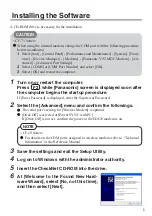
Assessing The Broad Business Case For Rugged Computing
______________________________________________________________________________________
Copyright © All Rights Reserved for Larstan Business Reports
3
“Anytime” connectivity implies an “anywhere” requirement. As people access
their network resources more often, they are also doing it from more places;
some of those places are not always computer friendly. That is why, in a
separate survey conducted by Harris Interactive, 70 percent of U.S. adult laptop
users (in a sample of 2,300 respondents) strongly agreed that they would not feel
comfortable storing their laptop in an overhead bin while traveling on an airplane
because of fear that it might become damaged. The survey further found that:
•
Among adults who regularly use a laptop computer, 47percent use their
laptop outside of a typical office environment on a daily basis;
•
25 percent regularly (i.e. 3 days a week or more) use a laptop while
traveling or somewhere else outside their home or work;
•
Among laptop users, 68 percent report their laptop is most at risk when
traveling as a result of being dropped and knocked against a hard surface
or getting crushed under the weight of other objects; and
•
39 percent reported experiencing some form of mishap (drop, knock, and
spill) with their laptop.
These findings are in line with research conducted in 2005 by Framingham, MA-
based IDC, which showed that dropping while carrying was the “number one”
cause of accidental notebook damage. Liquid spills and falls from a table or desk
rounded out the top three mishaps leading to accidental damage.
…Understanding the True Total Cost of PC Ownership
Many buyers have focused on purchase price alone when procuring notebooks.
A closer look at the numbers— and the quality of the end-user experience— is
turning this conventional wisdom into seriously outdated thinking.
According to a recent market research report authored by analyst David Krebs at
Natick, MA-based Venture Development Corporation, nearly 50% of the total cost
of operating an enterprise mobile computing device is caused by lost worker
productivity when the device fails.
He concludes that the upfront cost of hardware adoption accounts for only 16%
of mobile computer total cost of ownership (TCO). This implies substantial
savings with the purchase of rugged equipment, because operating costs will be
much lower over the long-term than with non-rugged mobile platforms.
This could explain why a study conducted by ABI Research in December of 2006
forecast that a new durable notebook category (also known as business-rugged)
will grow at a compound annual rate of over 16% between 2006 and 2011.





























